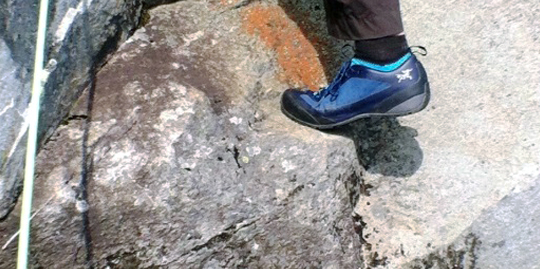[Photo] Tim Farr
MSRP $220.00
As a guide, I’ve burned through several pairs of approach shoes hiking up rough gullies and talus fields. When the Arc’teryx Acrux FL GTX showed up at my doorstep, I hoped they would last more than most. Over spring and summer, I used them on short and long approaches, through torrential thunderstorms, on muddy trails and over mountain scree.
Built with a double-layer design, with a non-removable liner similar to a neoprene bootie, the Acrux FL GTX feels like a stiff boot without ankle support. Their robust one-piece outer shell holds up to serious abuse. The waterproof, moisture-wicking liner and shock-absorbing footbed further softened my stride. When conditions were wet my feet stayed dry, which is something my other approach shoes don’t do.
These sturdy shoes are very stiff. The double-layer design, with a liner on the inside and layered plastic shell on the outside, is less sensitive and harder to climb in than the Five Ten Guide Tennie and La Sportiva Ganda. These other shoes, made with a single-layer design, are more malleable and have a softer, stickier rubber sole than the Acrux FL GTX. Even when smearing on the Acrux’s Climbing Zone, I didn’t notice any improved performance. They climb as I expected they would: like a blunt sole pressed against the rock and it was hard to feel nubbins under my feet. Their Vibram Megagrip rubber is too stiff to conform to stone. While these aren’t technical climbers, the Acrux FL GTX did perform admirably on low-angle slabs and scree fields.

[Photo] Steve Charest
What the Acrux FL’s soles lack in stickiness, they make up for by being more durable than other approach shoes. Toe and heel bumpers are seamlessly connected to the shoe’s Vibram sole and show little signs of wear, even after months of use. Unlike my Ganda and Guide Tennies, the soles of which have grown bald and thin after months of use, the Acrux FL still looks practically new after the same mileage.
I know it’s a small point, but at first I needed to cinch the laces down extra tight to keep them from loosening. Once the laces became fuzzy and broken in, they stayed in place.
Though my version of the Acrux don’t have removable liners, the next model up does, called the Acrux2. Liners are available in the following options: $85 (GORE-TEX), $90 (high-cut bootie-style GORE-TEX) and $95 (insulated, high-cut bootie-style GORE-TEX). The bootie-cut style liners stick out of the top of the shoes and look like gaiters, and though they can be used with the Acrux line, these liners fit best with Arc’teryx’s BORA line of hiking boots. The Acrux line comes in many models, and is available with removable liners and without. The non-removable liner, Acrux FL is $190 (non GORE-TEX). Add in a GORE-TEX liner and the shoes are $30 more, which is the version tested here. The Acrux2, made with a removable GORE-TEX liner, starts at $270. All Acrux shoes are tongue-free.
While not a do-it-all shoe, the Acrux FL is the most durable approach shoe I’ve worn.
Pros:
* Robust design
* Waterproof/breathable
* Though not as sticky as other approach shoes, they can climb in a pinch
Cons:
* Too stiff
* Double layer design is clunky
* They’re warm (perhaps too warm for muggy Northeast summers)
* Pricey
A previous version of this review stated that the liners in this model are removable.
Tim Farr is a Rock and Ice Climbing Guide and Instructor for Petra Cliffs Climbing Center based in Burlington, Vt. He is an Assistant Rock and Ice Guide and Certified Single Pitch Instructor through the AMGA. Farr also organizes Vermont’s Annual Ice Climbing Festival, the Smugglers’ Notch Ice Bash.